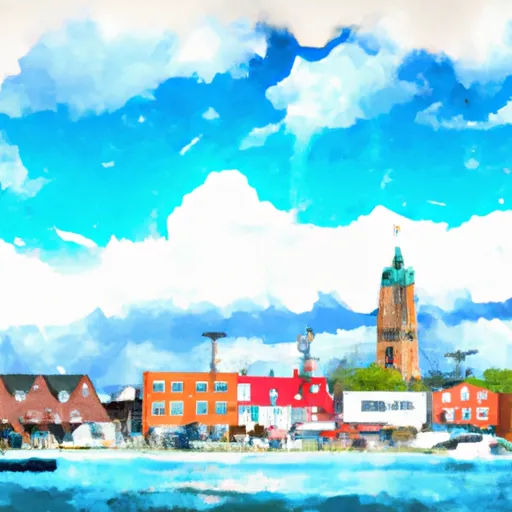-
 Snoflo Premium
Snoflo Premium
Get unlimited access to all our content
With no Ad interruptions! - Start Your Free Trial Login with existing account
South-Haven
Eden Index
Climate
7.9
•
Recreation
3.4
•
Community
2.3
•
Safeguard
4.9/10

South Haven, Michigan is a charming coastal town located on the shores of Lake Michigan. The climate in South Haven is classified as a humid continental climate, characterized by warm summers and cold winters. Summers are typically mild to warm, with average temperatures ranging from the 70s°F to low 80s°F. Winters are cold with temperatures often dropping below freezing, and snowfall is common.
As for hydrology constituents, South Haven is situated on the Black River, which flows into Lake Michigan. The river and lake offer excellent opportunities for water activities like boating, fishing, and swimming. The Black River is known for its diverse fish population, including salmon and trout, attracting anglers from near and far.
South Haven's outdoor recreation opportunities are abundant. The town boasts beautiful public beaches, such as South Beach and North Beach, where visitors can sunbathe, build sandcastles, or take a refreshing dip in Lake Michigan. The area is also known for its hiking and biking trails, including the Kal-Haven Trail, which spans over 30 miles from South Haven to Kalamazoo, offering scenic views of the countryside.
In conclusion, South Haven, Michigan offers a pleasant climate, a picturesque hydrology system, and numerous outdoor recreational opportunities, making it an ideal destination for nature enthusiasts and those seeking a beachside getaway.
What is the Eden Index?
The Snoflo Eden Index serves as a comprehensive rating system for regions, evaluating their desirability through a holistic assessment of climate health, outdoor recreation opportunities, and natural disaster risk, acknowledging the profound impact of these factors on livability and well-being.
Climate Health Indicator (CHI): 7.9
South-Haven receives approximately
910mm of rain per year,
with humidity levels near 80%
and air temperatures averaging around
10°C.
South-Haven has a plant hardyness factor of
6, meaning
plants and agriculture in this region thrive during a short period during spring and early summer. Most
plants will die off during the colder winter months.
By considering the ideal temperature range, reliable water supplies, clean air, and stable seasonal rain or snowpacks, the Climate Health Indicator (CHI) underscores the significance of a healthy climate as the foundation for quality living.
A healthy climate is paramount for ensuring a high quality of life and livability in a region, fostering both physical well-being and environmental harmony. This can be characterized by ideal temperatures, reliable access to water supplies, clean air, and consistent seasonal rain or snowpacks.
Weather Forecast
Streamflow Conditions
Southeastern Lake Michigan
Area Rivers
Southeastern Lake Michigan
Snowpack Depths
Southeastern Lake Michigan
Reservoir Storage Capacity
Southeastern Lake Michigan
Groundwater Levels
Recreational Opportunity Index (ROI): 3.4
The Recreational Opportunity Index (ROI) recognizes the value of outdoor recreational options, such as parks, hiking trails, camping sites, and fishing spots, while acknowledging that climate plays a pivotal role in ensuring the comfort and consistency of these experiences.
Access to outdoor recreational opportunities, encompassing activities such as parks, hiking, camping, and fishing, is crucial for overall well-being, and the climate plays a pivotal role in enabling and enhancing these experiences, ensuring that individuals can engage in nature-based activities comfortably and consistently.
Camping Areas
| Campground | Campsites | Reservations | Toilets | Showers | Elevation |
|---|---|---|---|---|---|
| Johnson County Park | 50 | 741 ft | |||
| Mason Ridge - Morgan Monroe State Forest | 30 | 707 ft | |||
| Yellowwood State Forest | 80 | 613 ft | |||
| Shamrock Park | None | 608 ft | |||
| Deer Creek Co Park | None | 702 ft | |||
| Morgan - Monroe State Forest | 30 | 941 ft | |||
| Potato Creek State Park | 290 | 783 ft | |||
| Eden Springs | 12 | 630 ft | |||
| Covert Park | 60 | 658 ft | |||
| Brown County State Park | 430 | 899 ft |
Nearby Ski Areas
Catastrophe Safeguard Index (CSI):
The Catastrophe Safeguard Index (CSI) recognizes that natural disaster risk, encompassing floods, fires, hurricanes, and tornadoes, can drastically affect safety and the overall appeal of an area.
The level of natural disaster risk in a region significantly affects safety and the overall livability, with climate change amplifying these risks by potentially increasing the frequency and intensity of events like floods, fires, hurricanes, and tornadoes, thereby posing substantial challenges to community resilience and well-being.
Community Resilience Indicator (CRI): 2.3
The Community Resilience Indicator (CRI) recognizes that education, healthcare, and socioeconomics are crucial to the well-being of a region. The CRI acknowledges the profound impact of these elements on residents' overall quality of life. By evaluating educational resources, healthcare accessibility, and economic inclusivity, the index captures the essential aspects that contribute to a thriving community, fostering resident satisfaction, equity, and social cohesion.

